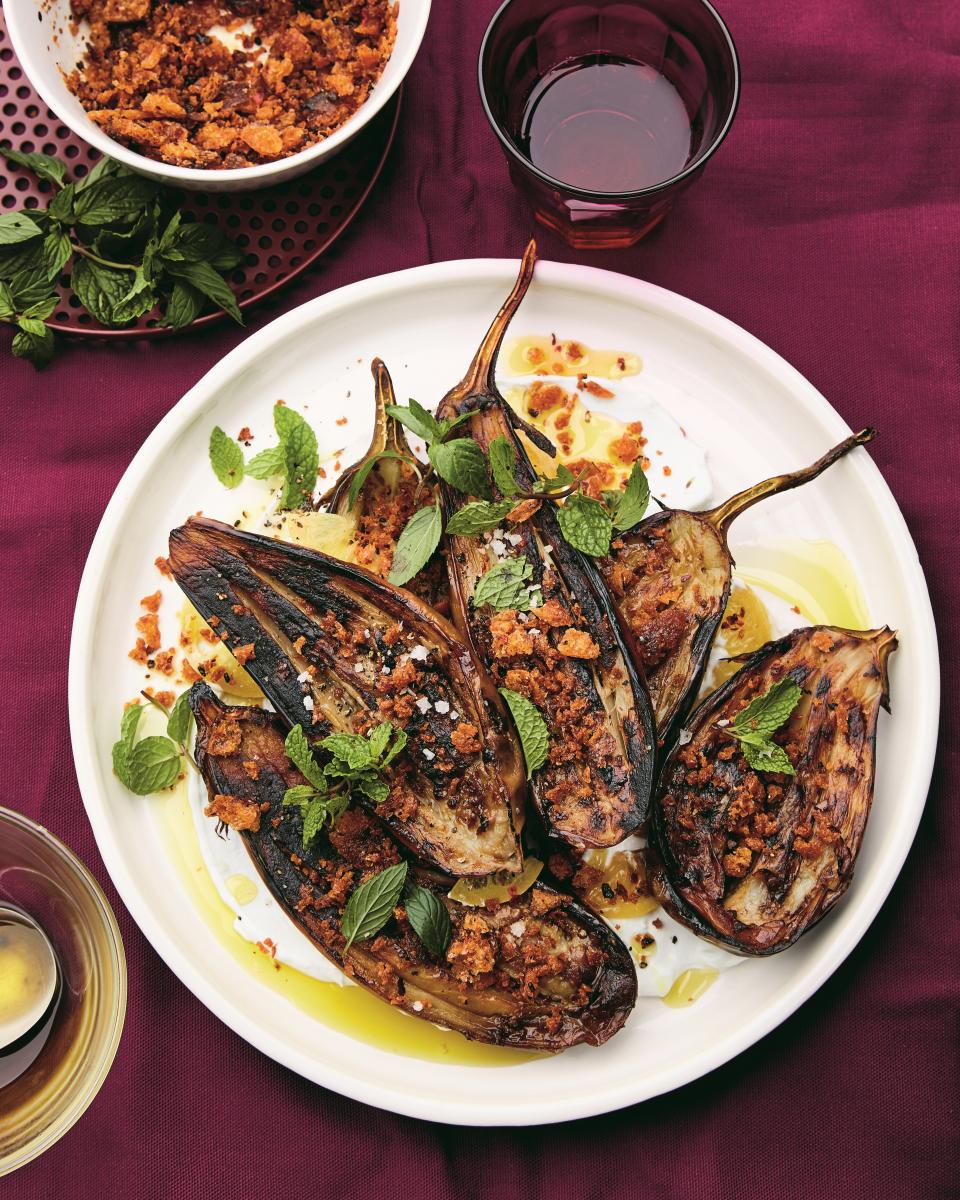Everyone Is Cooking Their Vegetables in Too Much Olive Oil and We Can't Get Enough
Epi contributor Molly Baz gets it. Fat—and salt and acid and heat—guru Samin Nosrat gets it. Cookbook author Alison Roman? Yeah, she gets it too. And the phrase of the day is: confit vegetables.
Who doesn't get it: French-cooking traditionalists. And that's because confit technically refers to slow-cooking animal protein submerged in its own fat—usually duck or goose which has been salt-cured overnight before cooking. The technique started out as a preservation tactic since the layer of fat that solidifies over the meat as it cools is a deterrent to all the things that make meat go bad (except perhaps an infestation of rats and raccoons).
And while we love a rich and tender bit of duck confit, right now we're obsessing instead over vegetable confit. That is, vegetables cooked in copious amounts of olive oil. Full disclosure though: we're being a little bit lenient with the term confit, even in regards to vegetables. While some of these recipes, like Molly's parsnips topped with cider-vinegar-plumped currants and Nosrat's cherry tomatoes with basil stems and garlic, are cooked completely submerged, others are merely cooked in more oil than you may think is wise (until you've tried it, that is).

Slow-Cooked Green Beans with Harissa and Cumin
Photo by Chelsie Craig, Food Styling by Claire SaffitzSuch is the case with this lush eggplant dish from Alison Roman's new cookbook Nothing Fancy. In her first book, Dining In, Roman details her method for Olive Oil–Roasted Vegetables—i.e. slow-roasting vegetables in, she writes, "obscene amounts of olive oil."
But while Dining In limits the technique to a two-page spread, Roman leans into the method in the follow up book—though her pours are a bit lighter-handed. Where in Dining In, Roman suggests covering veg with at least 1 1/2 cups of oil, the recipes in Nothing Fancy may start with onions sautéed in just 1/2 cup of olive oil. (Still, it's a much more generous pour than the standard recipe starter.)
When Senior Editor Maggie Hoffman tackled that eggplant dish, she doused the halved eggplants in the prescribed 1/2 cup of olive oil—which by no means covers them, but does allow the veg to be thoroughly coated, giving the spongy flesh no chance of drying out as the cut sides develop a deep, burnished surface and the interior turns custardy.

Long Roasted Eggplant with Garlic, Labne, and Tiny Chile Croutons
But that's not to say that covering vegetables in oil and cooking them long and low turns out greasy sides. Not at all. Instead, the vegetables get imbued with that savory, spicy note inherent in good olive oil (and, please, only use good olive oil for this). The vegetables collapse into something richer, something that tastes luxe but with very little work involved. In turn, the olive oil is infused with whatever sweetness or savoriness or spiciness the vegetables have to offer. And you can continue to use it: olive oil–poached chiles may be a great pizza topping, but that chile oil left behind can make a stand-out salad vinaigrette or a fried egg the likes of which you've never tasted.
About a year ago Epi contributor Claire Saffitz developed a series of slow-cooked, olive oil–drenched vegetable dishes for Bon Appétit. Tomatoes, acorn squash, green beans, eggplant, scallions, bell peppers, and zuchini all sank into casserole dishes of oil and aromatics. The resulting dishes were ready to smear on crostini, ready to toss with pasta for a one-and-done sauce, ready to sit astride a grilled pork chop, or to blend into a dip (as Maggie did with her leftover eggplant in lemon-labne sauce) that'll make you say "Hummus? Who's that? I don't know her."
Parsnip Confit with Pickled Currants
Bon Appétit
Here's how to do it at home:
1. Pick a Vegetable, Any Vegetable
Claire has shown us the way: Any vegetable—or combination of vegetables—will work for this technique. Garlic confit is classic, but dense fall produce is astounding for confit. Try celery root, turnips, carrots, pumpkins.
2. Chop (Most) Vegetables
Smaller, thinner veg (cherry tomatoes, green beans, etc.) can stay whole , but otherwise chop your vegetables into large, uniform pieces.
3. Choose Your Dish
Senior food editor Anna Stockwell outlines a method for stovetop confit here.
However, the most hands-off method is to do this in the oven, so pick an oven-safe dish that will hold your chosen chopped veg in one layer, packed closely together (a pan too big means you'll need more oil than necessary). Season it all with salt.
4. Pour in the Oil
Drench your vegetables in copious amounts of olive oil. You'll want the oil to come at least 1/2 way up the sides of the vegetable, but covering them completely with oil is even better and means you'll have to check on their progress even less. (If you're not covering completely, give every thing a toss to coat.)
5. Add Aromatics
A few cloves of garlic, some herb stems, a dried chile, whole cumin or fennel seeds: these will perfume your oil and your chosen star vegetables even more.
6. Slow-Roast
Slide the dish into an oven set to 350°F and roast vegetables for about 60 to 90 minutes, checking at the 45 minute mark to gauge doneness and caramelization. If you haven't covered your veg completely, you may want to stir the vegetables once or twice. Vegetables are done when they are caramelized and starting to char on any exposed bits.
Long-Roasted Eggplant with Garlic, Labne, and Tiny Chile Croutons
Originally Appeared on Epicurious


